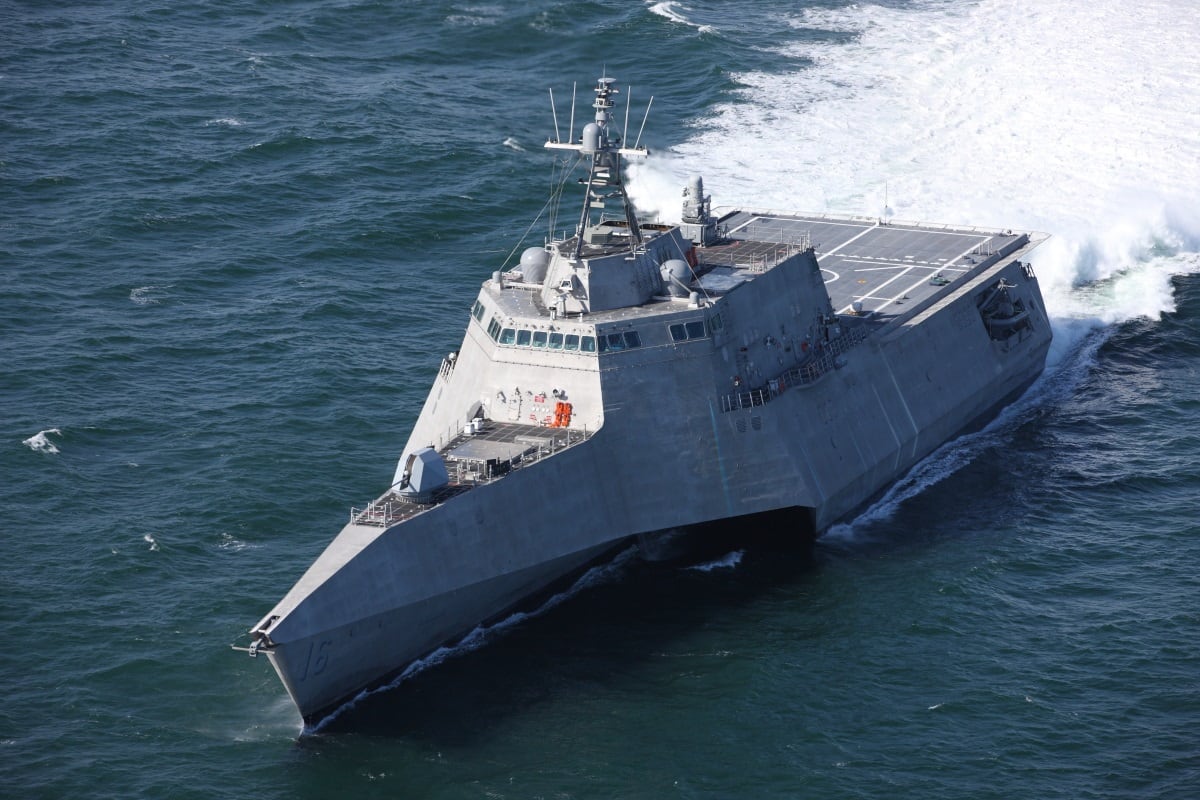WASHINGTON — The U.S. Navy’s littoral combat ship program endured another round of budget cuts this year to its mission modules, but all is not gloom for the Navy’s small surface combatants.
The service has made progress on fielding new ship-killing capabilities, demonstrated the ability to autonomously detect and then destroy a mine, and has accepted delivery of key components of the anti-submarine warfare package.
And, perhaps most importantly, the LCS have begun to deploy again after an 18-month hiatus, and they are making a contribution to the over-taxed Pacific Fleet. In November, the LCS Gabrielle Giffords conducted a close pass of Mischief Reef in the Spratly Islands, the first freedom-of-navigation operations conducted by an LCS since the ships began deploying again in July.
RELATED

But the Navy continues to have tough questions regarding the ships, like how they will fit into the Navy’s distributed maritime operations concept, which will see the fleet attempt to fight by spreading out over a wider area instead of aggregated around an aircraft carrier.
And can the fuel-inefficient ship type, built primarily for speed over shorter distances, make a meaningful contribution in distributed operations? The ships can dart around at speeds in excess of 40 knots, but to be at their most fuel efficient, they have to operate much slower, which could limit their utility in a sprawling, distributed fight in the Pacific with contested logistics trains, meaning it may not always have an oiler nearby to refuel.
Furthermore, the complicated propulsion system has proven to be tricky, raising questions about reliability.
Bryan Clark, an analyst and former submarine officer who works at the Center for Strategic and Budgetary Assessments, told Defense News it’s an open question as to what role the LCS will play in a distributed fleet architecture.
“Assuming the Navy is not going re-architect the propulsion system and address the range problem by adding additional fuel capacity to it, I think you’ve got what you’ve got,” the think tanker said. “So the key for the Navy will be to mitigate the limitation of LCS. Those are primarily range and reliability, which both get to the question of endurance. And then the other limitation it has, arguably, is the lack of a significant offensive capacity.”
Clark suggested the Navy use the LCS as a command-and-control platform for unmanned vessels.

“I think the Navy needs to mitigate those limitations by shifting the use of the LCS to much more of a command-and-control node and an unmanned vehicle support node,” Clark said. “For example, the [Independence-class] LCS-2 could be very useful as the host for unmanned surface vessels or unmanned underwater vessels or unmanned aerial vehicles. And then it could support the larger UUVs and USVs by having them come alongside and use the ship to provide support, repair and fuel to the unmanned vehicles.”
“Because then you can take advantage of the range of the unmanned vehicle to go do missions," he explained, "and the LCS doesn’t have to drive around, burn up fuel or risk getting stranded somewhere because of a propulsion problem.”
The LCS might still have a role in augmenting a surface action group of combatants such as the Navy’s stalwart Arleigh Burke-class destroyers in the near term. The addition of the Kongsberg-Raytheon Naval Strike Missile, which currently has among the longest anti-surface missile reach in the fleet, could add some firepower against enemy ships.
But even in the short term, the range issue rears its ugly head.
“The problem is the range limitations mean it’s going to have difficulty hanging with a surface action group — it will need to be refueled more often, come off station more often. So even though it has this longer range with the Naval Strike Missile, I don’t know if it is going to be a lot of value added in a surface action group because the surface action group in the near future will have other options to reach targets at that range with the SM-6 and Block 5 Maritime Strike Tomahawk [missiles].”
Needed capabilities
Jerry Hendrix, a retired captain and analyst with The Telemus Group, agreed that the Navy needs to find new uses, but said the force still needs many of the capabilities for which the ship was designed to address.
“The enduring problem is the lack of offensive punch,” Hendrix said. “It doesn’t have any VLS [vertical launching system] tubes, so I can’t pack any of the larger missiles on there. But the thing is I still need those mission modules. Especially the mine-countermeasures mission modules with the Avenger-class minesweepers going away.”
Hendrix said the Navy must field the mission modules and find new ways and places to deploy the ships to mitigate the range issues.
But Congress, frustrated by the long delays in fielding the mission modules, has continually slashed away at the funding for the mission modules. This has created delays in testing, which Congress then uses as justification for further cuts the following year.
While the Navy continues to debate what to do with its ships, shipbuilder Fincantieri’s Marinette Marine and Austal USA continue to push out new hulls with an undefined role.
Prime contractor Lockheed Martin announced Dec. 12 that it’s 10th Freedom-class LCS, the St. Louis, had completed acceptance trials. Lockheed is building the ship at a Fincantieri yard.
“As each Freedom-variant hull deploys, we seek out and incorporate fleet feedback and lessons learned to roll in capabilities for new hulls,” Joe DePietro, Lockheed Martin’s general manager for small combatants and ship systems, said in a news release. "As a result, LCS 19 includes a solid-state radar, upgraded communications suite, increased self-defense capabilities and topside optimization, among other updates.”
Austal USA announced its 11th littoral combat ship completed acceptance trials in late October.
David B. Larter was the naval warfare reporter for Defense News.








